Serviços Personalizados
Journal
Artigo
Indicadores
-
 Citado por SciELO
Citado por SciELO -
 Acessos
Acessos
Links relacionados
-
 Citado por Google
Citado por Google -
 Similares em
SciELO
Similares em
SciELO -
 Similares em Google
Similares em Google
Compartilhar
Revista EAN
versão On-line ISSN 0120-8160
Rev. esc.adm.neg no.79 Bogotá jul./dez. 2015
Integration of a framework with a learning management system for detection, assessment and assistance of university students with reading difficulties
Integración de un marco de detección, evaluación y asistencia a estudiantes universitarios con problemas lectores basado en un Sistema de administración del aprendizaje
La mise en place d'un cadre de référence au moyen d'un Système de Management de l'Apprentissage pour la détection l'assistance et l'évaluation des étudiants universitaires souffrant de difficultés de lecture
Integração do Modelo para Detecção, Avaliação e Assistência de estudantes uni versitários com Dificuldades de Leitura com um Sistema de Gestão de Aprendizagem
Carolina Mejía Corredor*
Ramón Fábregatb Gesa**
Daniel Salas Álvarez***
*Doctora en Tecnología por la Universitat de Girona (España) Profesor Titular de la Facultad de Estudios en Ambientes Virtuales de la Universidad EAN, Bogotá - Colombia.
** Doctor en Ingeniería Informática por la Universitat de Girona (España) Profesor Titular del Departamento de Arquitectura y Tecnología de Computadores de la Universitat de Girona, España.
*** Magister en Informática de la Universidad Industrial de Santander (Colombia) Decano de la Facultad de Ingenierías Universidad de Córdoba, Colombia
FECHA DE RECEPCIÓN: 23 de junio FECHA DE APROBACIÓN: 17 de julio
RESUMEN
La dislexia es una dificultad de aprendizaje común en estudiantes universitarios de habla hispana, que requiere de una atención especial por parte de las instituciones de educación superior para apoyar a los individuos afectados durante su proceso de aprendizaje. En estudios previos, fueron desarrolladas herramientas para detectar, evaluar y asistir estudiantes universitarios con dificultades lectoras relacionadas con la dislexia. En este artículo se presenta la integración de estas herramientas con un sistema de gestión de aprendizaje (LMS por su sigla en inglés). Con el fin de probar la funcionalidad y usabilidad de la integración, se desarrollaron dos estudios de casos. El primer estudio se llevó a cabo con 20 estudiantes, mientras el segundo se hizo con 4 profesores. Los resultados mostraron que tanto estudiantes como profesores estuvieron satisfechos con la integración realizada en Moodle.
Palabras clave: Dislexia, dificultades lectoras, sistema de gestión de aprendizaje (LMS por su sigla en inglés). Moodle, PIADA, servicios web, e-learning.
ABSTRACT
Dyslexia is a common learning disability in Spanish-speaking university students, and requires special attention from higher educational institutions in order to support affected individuals during their learning process. In previous studies, a framework to detect, assess and assist university students with reading difficulties related to dyslexia was developed. In this paper, the integration of this framework with a Learning Management System (LMS) is presented. Two case studies were performed to test the functionality and the usability of this integration. The first case study was carried out with 20 students, while the second one with four teachers. The results show that both students and teachers were satisfied with the integration performed in Moodle.ce, among others.
Key words: Dyslexia, reading difficulties, Learning Management System (LMS), Moodle, PIADA, web services, e-learning.
RESUMÉÉ
La dyslexie est un trouble de l'apprentissage commun chez les étudiants universitaires de langue espagnole et nécessite une attention particulière des institutions d'enseignement supérieur pour accompagner les étudiants atteints de ce trouble lors de leur processus d'apprentissage. Des études antérieures ont mis en place un cadre spécifique pour la détection, l'évaluation et l'aide aux étudiants souffrant de difficultés de lecture liées à la dyslexie. Cet article présente la mise en place de ce cadre de référence au moyen d'un Système de Gestion de l'Apprentissage (SGA).
Deux études de cas ont été réalisées pour tester la fonctionnalité et la facilité d'utilisation de cette intégration. La première étude a été réalisée avec 20 élèves tandis que dans la seconde 4 professeurs y ont participé. Les résultats montrent que les étudiants et les enseignants étaient satisfaits de l'intégration réalisée via la plateforme d'enseignement Moodle.
Mots clefs: Dyslexie; Difficultés de lecture; LMS; Moodle; PIADA; Services web; Enseignement à distance.
RESUMO
Dislexia é uma desordem de aprendizagem comum em estudantes universitários hispano falantes e requer uma atenção especial por parte das instituições de ensino superior em apoiar estudantes afetados durante o seu processo de aprendizagem. Em estudos anteriores um modelo para detectar, avaliar e auxiliar estudantes universitários com dificuldades de leitura relacionados a dislexia tem sido desenvolvido. Neste artigo, a integração deste modelo com o Sistema de Gestão de Aprendizagem (LMS) é apresentado. Dois estudos de caso foram desenvolvidos para testar a funcionalidade e a praticabilidade dessa integração. O primeiro caso estudado foi feito com 20 estudantes enquanto o segundo foi feito com 4 professores. Os resultados mostraram que estudantes e professores ficaram satisfeitos com o desempenho integracional no Moodle.
Palavras-chave Dislexia; dificuldades de leitura; LMS; Moodel; PIADA; serviços web; aprendizagem virtual.
1. INTRODUCTION
In the e-learning process, the development of Learning Management Systems (LMS) has been increasing, improving and being applied to support traditional face-to-face and distance learning processes, mainly because they are spaces to provide tools that enable the participation and interaction between students and teachers (Graf, 2007; Vélez, 2009; Vilches, 2007), and also because they have capabilities to allow the implementation of adaptations in order to achieve the personalization of learning. More specifically, some LMS can incorporate different user models that can be processed and inferenced so as to deliver different educational information tailored to the students' needs (Brusilovsky & Millán, 2007; Bull, Jackson, & Lancaster, 2010; Carmona, Castillo, & Millán, 2007; Fontenla, Caeiro, & Llamas, 2009; Gaudioso, 2002; Graf, 2007; Gutierrez et al., 2009; Laroussi, 2001; Virvou & Tsiriga, 2001).
Dyslexia is a common learning disability which may persist into adulthood (Bruck, 1993; Díaz, 2007; Gregg, 2007; Simmons & Singleton, 2006) and is specifically referred to the manifestation of different difficulties in reading. University students with this type of disability may experience difficulties during their academic careers, since reading is the basis of most, if not all, formal educational processes and has significant importance in many learning domains.
Generally speaking, university students are not questioned about their learning disabilities when they start their academic careers; therefore, the number of specific cases of students with dyslexia is unknown. Consequently, a considerable number of students enter university without having expected reading skills, and would require support to cope with high reading demands. Thus, higher educational institutions are in clear need of having specific resources to detect students with reading difficulties (i.e. dyslexia symptoms), and providing the required assistance.
For this reason, novel studies were conducted. First, a study that was focused on detecting Spanish-speaking university students who are affected with some reading difficulties (Mejia, Clara, & Fabregat, 2011; Mejia, Giménez de la Peña, & Fabregat, 2012; Mejia, 2009). Then, it became necessary to study the cognitive processes associated with reading that can be altered in these students (Díaz et al., 2013; Mejia et al., 2011, 2012). Finally, a study focused on seeking strategies to assist them overcoming their difficulties (Mejia, Bull, Vatrapu, Florian, & Fabregat, 2012; Mejia, Díaz, Florian, & Fabregat, 2012). Thus, the previous research outcome was a framework for the detection, assessment and assistance of university students with reading difficulties. This framework was implemented with software tools that are considered in learning models for students with dyslexia, and an adaptive component to deliver suitable and personalized support to those students. In this way, the learner model was designed by defining variables related to demographics, reading profile, learning styles, and cognitive traits. These variables can be used by an adaptation engine to deliver learning analytics and specialized recommendations that best suit each student's performance (Mejia & Fabregat, 2012; Mejia, 2013).
This paper presents the integration of the proposed framework with an LMS, so that this integration allows to include in the LMS the characteristics of students with dyslexia, including investigations about how to automatically identify their demographics, reading profile, learning styles, and cognitive traits, and how to provide assistance that fit their particular characteristics. Thus, a familiar environment that supports detection, assessment and assistance of these students is provided.
In order to test the functionality and the usability of this integration, two case studies were performed. The first case study was carried out with 20 students while the second one with four teachers.
2. RESEARCH PROPOSAL
In order to provide a solution that overcomes the main question of this research: how can detection, assessment and assistance be provided to students with reading difficulties in a LMS?, below, we present the integration of a framework with an LMS for detection, assessment and assistance of university students with reading difficulties proposed in previous work (Mejia & Fabregat, 2012; Mejia, 2013). In order to achieve this, three components were designed and developed, namely:
- (i) Framework Software Toolkit, cluster of software tools for retrieving and delivering the information processed in the proposed framework. As mentioned above, these tools were presented in previous works as follows: a set of forms to capture student demographics in Mejia, Clara, et al. (2011), a self-report questionnaire to detect reading difficulties in adults called ADDA in Mejia, Giménez de la Peña, et al. (2012), a self-report questionnaire to detect learning styles called ADEA in Mejia (2009), an assessment battery for dyslexia screening in adults called BEDA in Díaz et al. (2013); Mejia, Díaz et al. (2011) ; Mejia, Díaz, Jiménez et al. (2012), a dashboard of learning analytics for adults with dyslexia called PADA in Mejia, Bull et al. (2012) ; Mejia, Díaz, Florian et al. (2012), and an activities recommender for adults with dyslexia called RADA in Mejia, Díaz, Florian et al. (2012).
(ii) An LMS module to interact with the tools of the Framework Software Toolkit.
(iii) A communication bridge between the Framework Software Toolkit and the LMS module, whose architecture is based on web services. As first approach, the LMS used to implement the (ii) component was Moodle.
Thus, this section provides a complete picture of the technological proposal and goes through further descriptions of each specific component.
2.1 The Framework Software Toolkit
In this section, the developed software tools that make up the proposed framework are presented as a toolkit, as well as the carried out processes and the designed databases (Source).
The software tools are: the set of forms to capture student demographics; ADDA (acronym for Spanish name Autocuestionario de Detección de Dislexia en Adultos); ADEA (acronym for Spanish name Autocuestionario de Detección del Estilo de Aprendizaje); BEDAj (acronym for the Spanish name" Batería de Evaluación de Dislexia en Adultos); PADA (acronym for the spanish name Panel de Analíticas de Aprendizaje de Dislexia en Adultos); and RADA (acronym for the spanish name Recomendador de Actividades para la Dislexia en Adultos).
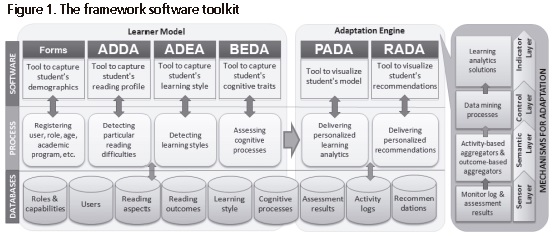
These tools are independent of any educational software system. This software toolkit is the materialization of the main tools of the framework that was proposed in previous research work, and it combines a Learner Model and Adaptation Engine for the "Delivery of personalized learning analytics" and the "Delivery of personalized recommendations".
The Framework Software Toolkit, as a set of tools, was built to perform a set of processes that aim to provide educational stakeholders with suitable support for:
- Registering users and including information about their role, age, gender, educational institution, faculty, academic program, etc.
- Detecting particular reading difficulties for identifying students' reading profile.
- Detecting the learning style of students.
- Assessing cognitive processes associated with reading in Spanish for identifying cognitive deficits.
- Delivering personalized learning analytics for creating awareness and facilitating reflection and self-regulation during the learning process.
- Delivering personalized recommendations for supporting the self-regulation of the students.
2.2 The LMS Module
The exemplary LMS used in this research work was Moodle. This is an LMS with great pedagogical and technological flexibility and usability that is supported by a large community of developers and users around the world. Moodle has been developed as an open source educational application with a free software license, and is currently the LMS that is used at the University of Girona and the University of Cordoba. Particularly, Moodle is characterized by its simple interface, lightweight, and efficiency, which can manage great amounts of educational resources, and that is easy to install. It is developed in PHP, and works with different database managers such as Postgres, MySQL, etc. Moreover, it can be installed in Linux or Windows operating systems and works with any web server that supports the appropriate version of PHP, although the most widely used web server is Apache.
A relevant characteristic of Moodle to this research work is its interoperability, by allowing the exchange of information with external software systems or tools. This can be achieved by the supported protocols in Moodle (such as SOAP and XML-RPC) for implementing the communication with a web service. This feature of interoperability using web services facilitates the integration of the Framework Software Toolkit proposed with this LMS.
Additionally, Moodle is designed in a modular way, allowing new additions or modifications to be incorporated (without changing the source code) so as to facilitate its updating and growth. Thus, Moodle consists of "modules" which provide users with different functionalities such as courses management, class assignments, homework alerts, collaborative tools (e.g. forums, chat, etc.) management, and quizzes assignment, among others. The stable structure of Moodle has some default modules for working, but more extensions (other modules) can be installed to deploy more functionalities.
Also in Moodle, there are small modules called blocks which are considered extras that complement and support teachers and students to manage and perform activities in the corresponding courses. The stable builds of Moodle already come with several default blocks installed, although like in the modules, more extensions can be added. Some examples of these blocks are: a calendar, external RSS feeds, course description, a translator, etc.
In this paper, a block named PIADA (acronym for the Spanish name Plataforma de Intervención y Asistencia de Dislexia en Adultos), which allow users to interact with the tools in the Framework Software Toolkit was developed. To this end, PIADA was developed following the Moodle guidelines.
PIADA's design involves two identified user roles that can interact with the tools in the Framework Software Toolkit, namely:
- Teacher", or users responsible for installing the block in their courses, reviewing the learning analytics of the students enrolled in their courses, and viewing recommendations given by experts (e.g., educational psychologists) for each student with cognitive deficits; and
- Student", or users who access the block and can view their reports.
Shows the activity diagram for PIADA. This diagram shows that the student is able to register, view tools, access tools, view progress notifications, and view results, while the teacher is able to view tools, access tools, and view results.
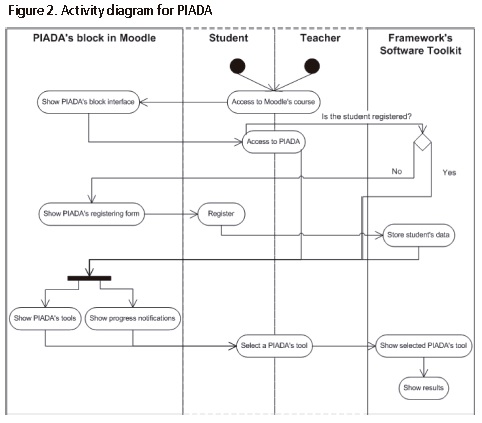
Thus, PIADA could be accessed by students and teachers as a complementary activity of a course that a teacher manages and in which students are enrolled. It is shows a summary of the requirements followed for the development of PIADA (Table 1).
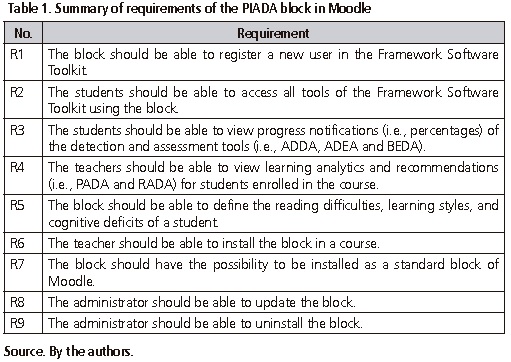
The development of the block was supported and performed using the wizard site builder offered by Moodle. This wizard created a new folder within the Moodle blocks structure with the name "piada", in lowercase, to identify this new module. The functionalities for interacting with the Framework Software Toolkit within the block were developed using PHP and JavaScript.
The interfaces of the PIADA block were divided into two groups depending on the user's role or who can access the tools (student and teacher). The group of interfaces for a student allows accessing and visualizing the tools of the Framework Software Toolkit, while the group of interfaces for a teacher allows visualizing the learning analytics and recommendations for the students.
In the case of the student role, once a student accesses PIADA, a new browser window, divided into two sections, shows up. At the top of that window, icons for accessing each tool of the Framework Software Toolkit from Moodle are displayed (see (a) in Source.
At the bottom of that screen, a panel with notifications of the progress performed in the tools related with the student model is displayed (i.e., forms, ADDA, ADEA and BEDA), see (b) in Source (Figure 3).
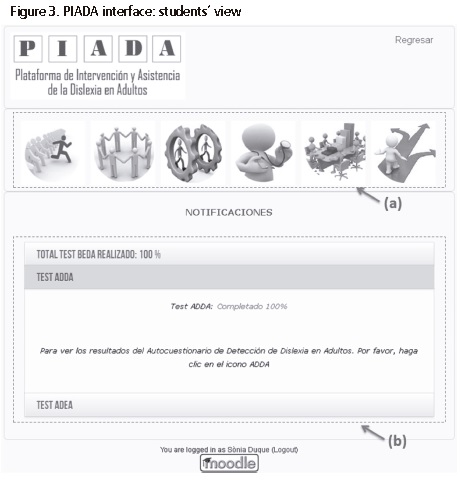
In the case of the teacher role, once a teacher accesses PIADA, a list with students enrolled in his/her course is displayed (see ). On the right side of that interface, the teacher can enter to any of both: the analytics of learning (i.e., PADA) (see (a) in ), or the recommendations (i.e., RADA) (see (b) in ), and furthermore, see each student's results. These results will let the teacher decide and deliver appropriate activities and resources to students regarding their needs (Figure 4).
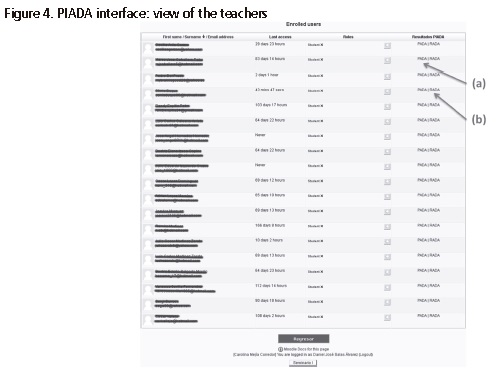
2.3 Integration Architecture based on Web Services
As presented in the previous section, a block in Moodle named PIADA was developed so as the Framework Software Toolkit can be accessed and used by university teachers interested in detecting, assessing, and assisting students who may have reading difficulties. The capabilities of Moodle to support web service technologies were used to communicate Moodle and the Framework Software Toolkit so as to achieve the proposed integration (Figure 5).
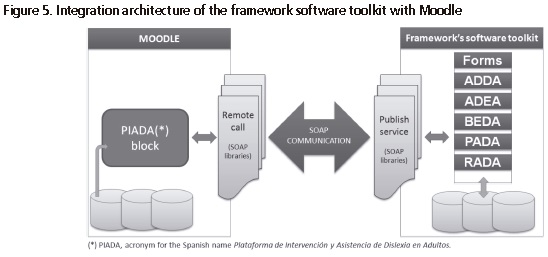
The integration architecture is based on the communication between the LMS and the Framework Software Toolkit. The communication protocol used in this architecture was SOAP . This communication is achieved by developing a set of web services (published by the Framework Software Toolkit) that allow PIADA in the LMS to retrieve data from and send data to the tools of the Framework Software Toolkit.
In general, web services allow web-based systems to exchange data between them regardless of the programming language with which they were created, the operating system or platform where they run and the device from where they are accessed.
More precisely in this research work, data exchanging through web services is typically performed using XML for sending requests and responses, between a system that operates as a server (the Framework Software Toolkit) and other system that operates as a client (PIADA) see Source.
The SOAP protocol was used to achieve XML-based requests and responses. SOAP is a standardized messaging language defined by W3C , which is typically conveyed using HTTP and that relies on XML for its message format. Moreover, SOAP specifies all the necessary rules for locating web services, integrating web-based systems and managing communication between them. Represents how data exchange is carried out through SOAP (Figure 6).
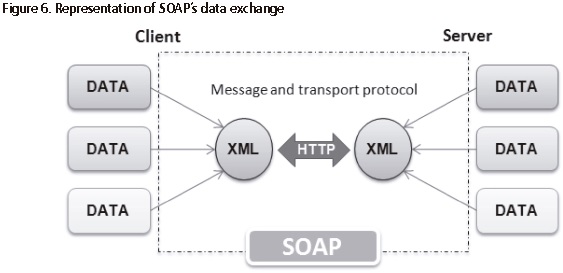
The SOAP libraries (i.e., NuSOAP) used in the development of the integration, allow exchanging data by publishing services in the Framework Software Toolkit, and by using these services through remote calls made by PIADA (see Source.
NuSOAP is a group of PHP classes that allow developers to create and use SOAP web services that can be used with Moodle, aiming at communication with other systems.
Different web services were built to achieve the proposed integration.
3. CASE STUDIES
Two case studies were performed to test the functionality and the usability of the integration of the PIADA block with the LMS. The first case study was carried out with students while the second one was with teachers.
3.1 Case study with students
3.1.1 Method
Ten students from the University of Girona (Spain) and 10 students from the University of Cordoba (Colombia) participated in the case study. More than five students were asked to carry out this case study, because according to Nielsen (2000), Spool and Schroeder (2001), and Virzi (1992), the functionality and usability tests with at least five students provide the most information about the problems presented by the tools. For these samples, both male and female students from engineering programs, aged between 22 and 27 (M=24.58, SD=2.193), were selected. Whether or not the student had dyslexia was not taken into account, because the aim of this case study was to assess the functionality and usability of the PIADA block.
During the case study, students were accompanied by a teacher experienced in managing Moodle and the PIADA block. When students had finished reviewing the block, the teacher asked them to fill an online survey and intended to evaluate the functionality and usability of the PIADA block.
As shown (Table 2), the survey method to gather students' comments consisted of 15 evaluation questions. Eleven questions where the students chose the most appropriate response on a scale of 1-5, based on their perception; and three open-end questions to inquire the reason for some of the previous answers; these are marked with an asterisk (*). In addition, at the end of the survey one open-end question to include more comments if students wished.
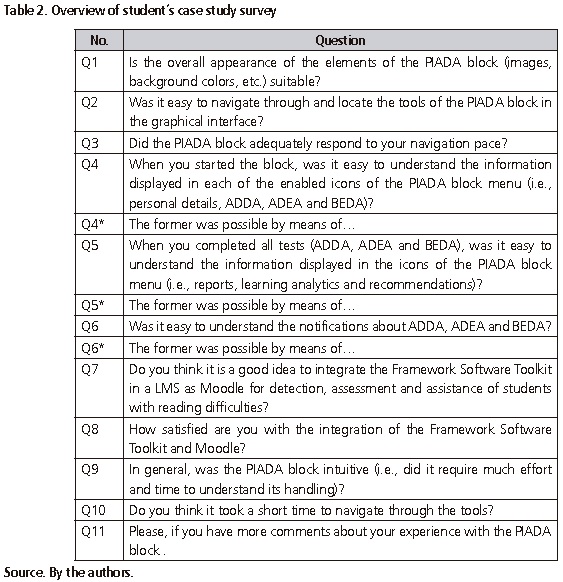
3.1.2 Results
The students' answers showed that appearance and navigability of the PIADA block were satisfactory. Furthermore, it was very user friendly and intuitive: the students never had questions about how to access and use the block. Students also think it is a good idea to integrate the Framework Software Toolkit with an LMS, and they were satisfied with the integration performed in Moodle. However, they indicated that to navigate through all the tools was time consuming. The results obtained out of the questions, are presented in below (Table 3).
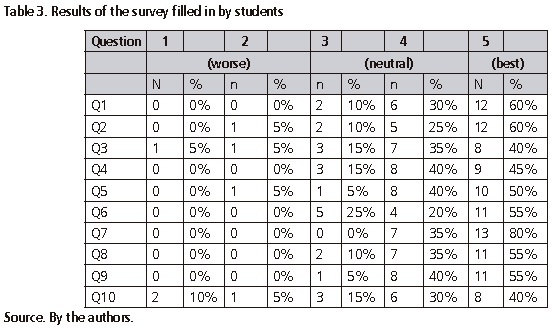
In terms of understanding the information displayed in the icons of the PIADA block menu, students indicated that they achieved an easy comprehension of each tool, as well as progress notifications. Although several comments were repeated in Q11 (see Table 2), and some were not significant, it highlights that: "because there is a brief introduction to each tool", "because the information is accompanied by graphs and descriptive texts", "because the notifications show the progress percentages of each tool". Finally, at the end of the survey, students gave opinions for improving the experience with the block; most of them to better understand the use of the different tools.
3.1.3 Discussion
The main focus of this case study was assessing the functionality and usability of the Moodle PIADA block, which supports university students with reading difficulties. Generally speaking, the results were very positive. In addition, the understanding of the contents of the block was good, so that, the authors believed that this block could be used to facilitate the learning process of students with reading difficulties through an LMS.
In addition, it is necessary to extend this case study to test the functionality of the Framework Software Toolkit to be integrated in other LMSs (e.g., dotLRN or ATutor), since this research work only considers the LMS Moodle to exemplify the integration.
Finally, it is worth noting that the integration with Moodle required a great effort and time by the author and collaborators in the analysis and development of the block. Thus, it was necessary to study and understand Moodle's architecture for the development of new blocks, and to learn how to use the workspace within Moodle for the development and management of style sheets. It was also important to have skills in developing Web service-oriented applications and to implement these services in Moodle. It is believed that similar efforts will be required to do this integration with other LMS.
3.2 Case study with teachers
3.2.1 Method
Two teachers from the University of Girona (Spain) and two teachers from the University of Cordoba (Colombia) participated in this case study. Teachers were from the humanities and engineering programs with a pedagogical experience between 5 and 16 years. The case study is based on interviews with participants, during which they reviewed the PIADA block and exposed their comments in order to evaluate its usability and usefulness. Three questions were answered during the interview:
- Did you find it easy to navigate through and locate the PIADA block in Moodle?
- Do you think it is a good idea to integrate the Framework Software Toolkit in a LMS as Moodle for detection, assessment and assistance of students with reading difficulties?
- Do you think that the PIADA block can help you in reflecting and making decisions to improve your teaching strategies?
3.2.2 Results
In terms of usability, interviews with the teachers showed that the PIADA block is fairly easy to access and to use. Additionally, as students, they think it is a good idea to integrate the Framework Software Toolkit with Moodle, although they expressed some drawbacks for its use in their classes: "it is quite difficult to promote the use of these tools due to our current academic load", "Moodle in the university is limited to share resources (i.e., documents, assignments, exercises, etc.)", "I think it will be difficult to promote these tools among students because they do not like to use them".
In relation to the usefulness of the PIADA block, interviews showed that teachers need more time to understand the meaning of learning analytics and recommendations displayed (i.e., PADA and RADA). One of the engineering teachers said that the recommendations were addressed to the teachers of the education and psychology faculty, and consequently they were hard to understand. Teachers also indicated that although they would need additional hours of work, they were willing to seek alternatives that would allow them to support students with difficulties.
3.2.3 Discussion
Similar to the students' study, this case study assessed the usability of the PIADA block, and its usefulness from the teachers' perspective. The results were positive. Some teachers' opinions suggest a revision of the PIADA block in order to provide better services. These suggestions will be taken into account for further versions of this block.
Findings of this study need to be viewed in light of some limitations. First, the PIADA block is a tool to access, visualize and use the Framework Software Toolkit, although it has available information about reading difficulties, learning styles and cognitive deficits of the students, these are not used in the LMS to produce appropriate learning resources. Second, this research work only considered the evaluation of the functionality and usability of the block for students; it is necessary to continue this work to assess the usefulness and effectiveness of this block with larger groups of students. Third, there is, of course, a need to replicate the interviews with a larger sample of teachers. Finally, future work has to include the execution of additional experiments with diagnosed dyslexic students. This is because dyslexic students may be familiar with similar tools, which could provide different perspectives on the use and usefulness of the block.
4. CONCLUSIONS AND FUTURE WORK
Firstly, based on the review of the literature, authors are focused on university students with dyslexia, a population that has been studied very little. University students with this type of disability may experience difficulties during their academic careers, since reading is the basis of most, if not all, formal educational processes and has significant importance in many learning domains.
It is concluded then, that the higher educational institutions are in clear need of specific resources to detect students with reading difficulties, and to provide them with the required assistance. In this sense, methods and tools to detect, assess and assist Spanish university students with reading difficulties are needed and therefore were proposed.
In order to integrate the tools of the framework for detection, assessment and assistance of students with reading difficulties with an LMS, an architecture based on web services was proposed. Above, it is stated that this integration, besides these tools having the possibility of being used independently from an LMS, it enables working within a specific LMS, so as to achieve interoperability of the tools in an e-learning process.
The exemplary LMS used in this research work was Moodle. This is an LMS with great pedagogical and technological flexibility and usability that is supported by a large community of developers and users around the world. It is an open source educational application, and is currently the LMS used at the University of Girona, as well as other universities that have contributed in the development of this research work.
A block named PIADA, which allows students to interact with the tools of the framework, was developed. Thus, teachers can install this block in their courses, and review the learning analytics of the students enrolled in their courses, as well as check the recommendations given by experts to each student with cognitive deficits; and the students can access each of the detection and assessment tools as well as the assistance tools through Moodle.
According to the results presented in the case studies, both students and teachers were satisfied with the integration performed in Moodle. Additionally, teachers indicated that although they would need additional hours of work, they were willing to seek alternatives that would allow them to support students with difficulties.
From these findings it is expected that this integration provides students a familiar environment that supports detection, assessment and assistance of reading difficulties related to dyslexia, as well as encourage teachers to revise their teaching practices in order to adapt them to the needs of students with reading difficulties.
Finally, as mentioned before, in this research work we only considered the evaluation of the functionality and usability of the block for students; it is necessary to continue this work to assess the usefulness and effectiveness of this block with larger groups of students. There is, of course, a need to replicate the interviews with a large sample of teachers. Additionally as future work, we propose the design and development of accessibility testing scenarios in order to verify the easiness of the solutions presented in this research work to meet the users' access needs. Future work has to include the execution of additional experiments with diagnosed dyslexic students.
5. REFERENCES
Bruck, M. (1993). Word recognition and component phonological processing skills of adults with childhood diagnosis of dyslexia. Special Issue Phonological Processes and Learning Disability, 13(3), pp. 258-268. http://doi.org/10.1006/drev.1993.1012. [ Links ]
Brusilovsky, P., & Millán, E. (2007). User Models for Adaptive Hypermedia and Adaptive Educational Systems. The Adaptive Web, LNCS 4321, pp. 3-53. [ Links ]
Bull, S., Jackson, T. J., & Lancaster, M. J. (2010). Students ' interest in their misconceptions in first year electrical circuits and mathematics courses. International Journal of Electrical Engineering Education, 47(3), pp. 307-318. [ Links ]
Carmona, C., Castillo, G., & Millán, E. (2007). Discovering Student Preferences in ELearning. In International Workshop on Applying Data Mining in e-Learning, 305, pp. 33-42. [ Links ]
Díaz, A. (2007). Perfiles cognitivos y académicos en adolescentes con dificultades de aprendizaje con y sin trastorno por déficit de atención asociado a hiperactividad (Ph.D. Thesis). Universidad de la Laguna, La Laguna, Spain. [ Links ]
Díaz, A., Jiménez, J. E., Mejia, C., & Fabregat, R. (2013). Estandarización de la Batería de Evaluación de la Dislexia en Adultos (BEDA). In M. del C. Pérez Fuentes & M. del M. Molero Jurado (Eds.), Variables Psicológicas y Educativas para la Intervención en el Ámbito Escolar. Presented at III Congreso Internacional de Convivencia Escolar: Contextos Sicológicos y Educativos (Asociación, pp. 191-194). GEU Editorial. [ Links ]
Fontenla, J., Caeiro, M., & Llamas, M. (2009). Una Arquitectura SOA para sistemas de e-Learning a través de la integración de Web Services. V Congreso Iberoamericano de Telemática. CITA 2009, 5, pp. 22-29. [ Links ]
Gaudioso, E. (2002). Contribuciones al modelado del usuario en entornos adaptativos de aprendizaje y colaboración a través de Internet mediante técnicas de aprendizaje automático (Ph.D. Thesis). Universidad Complutense de Madrid, Madrid, Spain. [ Links ]
Graf, S. (2007). Adaptivity in Learning Management Systems Focussing on Learning Styles (Ph.D. Thesis). Vienna University of Technology, Vienna, Austria. [ Links ]
Gregg, N. (2007). Underserved and Unprepared: Postsecondary Learning Disabilities. Learning Disabilities Research and Practice, 22, pp. 219-228. Retrieved from http://doi.org/10.1111/j.1540-5826.2007.00250.x. [ Links ]
Gutierrez, E., Boticario, J. G., Santos, O. C., Barrera, C., Rodríguez, A., Couchet, J., & Granado, J. (2009). Avances españoles y europeos en e-learning personalizable y adaptable. I Congreso Internacional Sociedad Digital, 14, pp. 182-195. [ Links ]
Laroussi, M. (2001). Conception et réalisation de système didactique hypermédia adaptatif: CAMELEON (Ph.D. Thesis). Manouba University. [ Links ]
Mejia, C. (2009). Adaptation Process to Deliver Content based on User Learning Styles (Master Thesis). Universitat de Girona, Girona, Spain. [ Links ]
Mejia, C. (2013). Framework for Detection, Assessment and Assistance of University Students with Dyslexia and/or Reading Difficulties (Ph.D. Thesis). Girona, Spain: University of Girona. [ Links ]
Mejia, C., Bull, S., Vatrapu, R., Florian, B., & Fabregat, R. (2012). PADA : a Dashboard of Learning Analytics for University Students with Dyslexia. In LastScandLE Seminar in Copenhagen (pp. 9-11). Retrieved from http://www.itu.dk/people/rkva/ScandleSeminar_CPH/doctoralConsortium/Paper-ScandLE_Seminar(Mejia).pdf. [ Links ]
Mejia, C., Clara, J., & Fabregat, R. (2011). DetectLD: Detecting university students with learning disabilities in reading and writing in the Spanish language. In T. Bastiaens & M. Ebner (Eds.), World Conference on Educational Multimedia, Hypermedia & Telecommunications - ED-MEDIA pp. 1122-1131. Chesapeake: VA: AACE. [ Links ]
Mejia, C., Díaz, A., Florian, B., & Fabregat, R. (2012). El uso de las TICs en la construcción de analíticas de aprendizaje para fomentar la autorregulación en estudiantes universitarios con dislexia. In Congreso Internacional EDUTEC. [ Links ]
Mejia, C., Díaz, A., Jiménez, J. E., & Fabregat, R. (2011). Considering Cognitive Traits of University Students with Dyslexia in the Context of a Learning Management System. In D. D. Schmorrow & C. M. Fidopiastis (Eds.), Foundations of Augmented Cognition. Directing the Future of Adaptive Systems. presented at 14th International Conference on Human-Computer Interaction (HCII 2011) (pp. 432-441). Springer Berlin Heidelberg. Retrieved from http://doi.org/10.1007/978-3-642-21852-1_50. [ Links ]
Mejia, C., Díaz, A., Jiménez, J. E., & Fabregat, R. (2012). BEDA: A Computerized Assessment Battery for Dyslexia in Adults. Procedia-Social and Behavioral Sciences, 46, 1795-1800. Retrieved from http://doi.org/10.1016/j.sbspro.2012.05.381. [ Links ]
Mejia, C., & Fabregat, R. (2012). Framework for Intervention and Assistance in University Students with Dyslexia. In IEEE International Conference on Advanced Learning Technologies (ICALT) pp. 342-343. [ Links ]
Mejia, C., Florian, B., Vatrapu, R., Bull, S., & Fabregat, R. (2013). A novel web-based approach for visualization and inspection of reading difficulties on university students. Computers & Eduvation. [ Links ]
Mejia, C, Giménez de la Peña, A., & Fabregat, R. (2012). ATLAS versión 2: una experiencia en la Universitat de Girona. In XXVIII Congreso Internacional AELFA: Asociación Española de Logopedia, Foniatría y Audiología. [ Links ]
Simmons, F. R. & Singleton, C. (2006). The arithmetical abilities of adults with dyslexia. Dyslexia, 12, 96-114. [ Links ]
Vélez, J. (2009). Entorno de aprendizaje virtual adaptativo soportado por un modelo de usuario integral (Ph.D. Thesis). University of Girona, Girona, Spain. [ Links ]
Vilches, E. (2007). Analysis of steps of the platform of virtual learning Microcampus at The University Estatal to Distance of Costa Rica. Revista Electrónica INIE, 1-34. [ Links ]
Virvou, M., & Tsiriga, V. (2001). Web Passive Voice Tutor: an Intelligent Computer Assisted Language Learning System Over The WWW. In IEEE International Conference on Advanced Learning Technologies (pp. 131 - 134). [ Links ]













